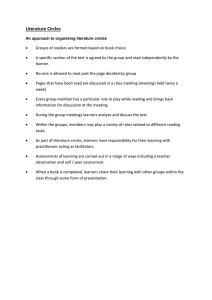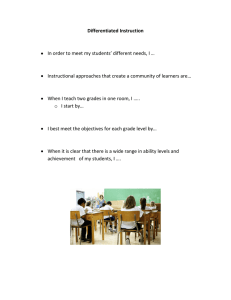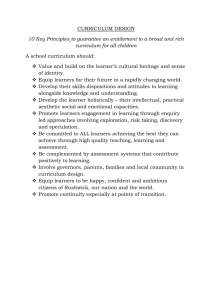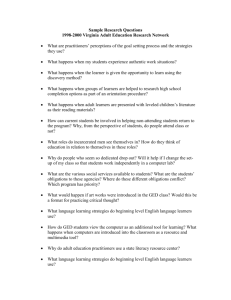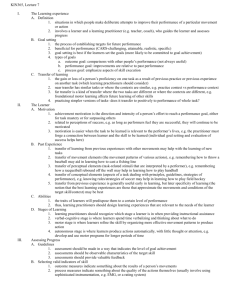Advice for practitioners Background
advertisement
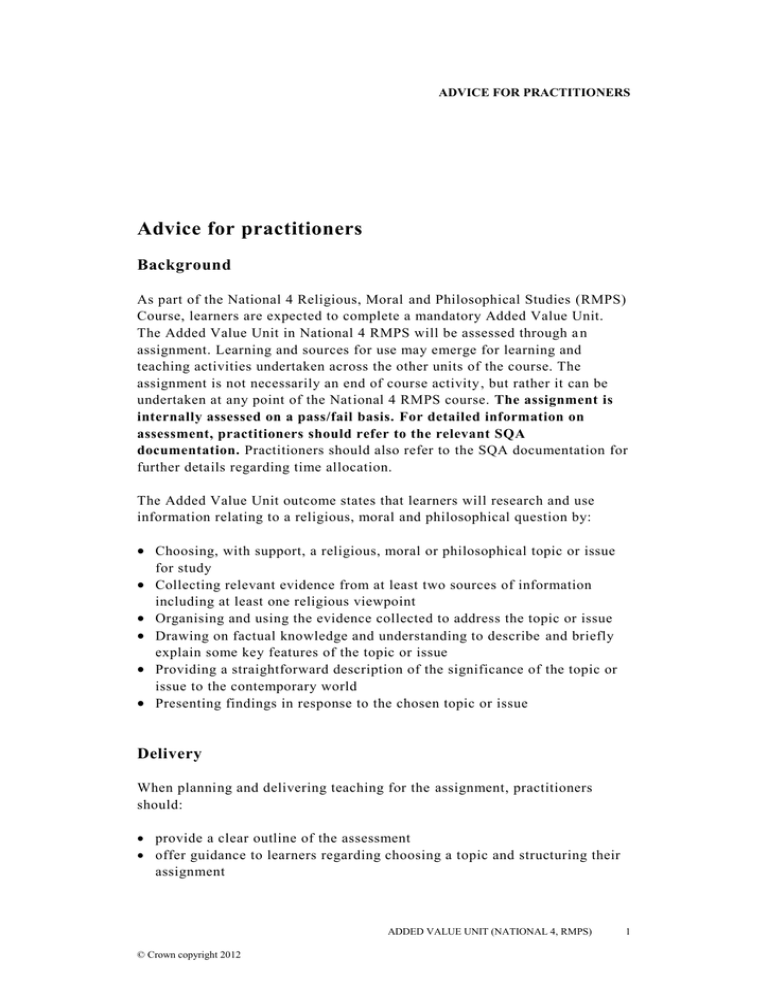
ADVICE FOR PRACTITIONERS Advice for practitioners Background As part of the National 4 Religious, Moral and Philosophical Studies (RMPS) Course, learners are expected to complete a mandatory Added Value Unit. The Added Value Unit in National 4 RMPS will be assessed through a n assignment. Learning and sources for use may emerge for learning and teaching activities undertaken across the other units of the course. The assignment is not necessarily an end of course activity , but rather it can be undertaken at any point of the National 4 RMPS course. The assignment is internally assessed on a pass/fail basis. For detailed information on assessment, practitioners should refer to the relevant SQA documentation. Practitioners should also refer to the SQA documentation for further details regarding time allocation. The Added Value Unit outcome states that learners will research and use information relating to a religious, moral and philosophical question by: Choosing, with support, a religious, moral or philosophical topic or issue for study Collecting relevant evidence from at least two sources of information including at least one religious viewpoint Organising and using the evidence collected to address the topic or issue Drawing on factual knowledge and understanding to describe and briefly explain some key features of the topic or issue Providing a straightforward description of the significance of the topic or issue to the contemporary world Presenting findings in response to the chosen topic or issue Delivery When planning and delivering teaching for the assignment, practitioners should: provide a clear outline of the assessment offer guidance to learners regarding choosing a topic and structuring their assignment ADDED VALUE UNIT (NATIONAL 4, RMPS) © Crown copyright 2012 1 ADVICE FOR PRACTITIONERS be aware that learners may benefit from a choice of topi c that the practitioner has expertise in and resources for offer guidance and direction regarding source materials, if required , and, where relevant, explain why these resources are useful . Planning It is important to remember that support and guidance will be needed in helping learners identify an area that they wish their assignment to focus on. The topic for the assignment can emerge from any religious, moral or philosophical topic or issue. Practitioners could consider sharing with learners: (a) (b) examples of different topics or issues that could be chosen exemplar questions or areas of focus from within a specific topic. The table below gives some examples of questions that could be considered. These questions are only included for exemplary purposes. Learners should be actively encouraged to select an area of the RMPS course which is of interest to them, rather than choose from a prescribed list of questions. Does the Eightfold Path provide a good pattern for living life? Why do some people say that Buddhism is a selfish religion? How do Buddhists reach enlightenment? Why do Christians pray? What do Jesus miracles tell us about him? What do Christians believe about forgiveness? In what ways does the Hindu belief in karma help explain the existence of suffering and evil? What is helpful and challenging about the Hindu caste system? Is the Hindu belief in Ahimsa relevant today? Why is it important for Muslims to live life according to the Five Pillars? Is it easier to follow Islam in a Muslim country than in Scotland? How do Muslims use the Qur’an? 2 ADDED VALUE UNIT (NATIONAL 4, RMPS) © Crown copyright 2012 ADVICE FOR PRACTITIONERS Are the Ten Commandments the most important rules for Jews to follow? Why do Jewish people celebrate Hanukkah? What problems are raised by the Jewish belief that Israel is their Promised Land? What makes a good Sikh? Who was Guru Nanak and why is he so important for Sikhs? Is the Sikh idea of reincarnation realistic? Should the UK bring back the death penalty? Is capital punishment acceptable in the 21st century? What is the main purpose of punishing cr iminals? In what ways can gender stereotypes be harmful? How are men and women treated differently around the world? What do religions teach about homosexuality? Do religious believers do enough to care for the environment? How does fairtrade help the poor? Is giving to charity a duty? Should voluntary euthanasia be legal in the UK? Do embryos have rights? What do religions believe about organ donation? Are nuclear weapons necessary in the modern world? Does pacifism make sense? Is war ever right? Why does evolution challenge some religious believers? Does the Big Bang disprove God? Are religious creation stories outdated and irrelevant? ADDED VALUE UNIT (NATIONAL 4, RMPS) © Crown copyright 2012 3 ADVICE FOR PRACTITIONERS Practitioners should also attempt to make the planning process as active and collaborative as possible. For the assignment, planning and the process of researching are not the assessable elements therefore it is not necessary for learners to produce a plan for the assignment. However, it may be useful for learners to consider some of the following elements in the development of their assignment. It is important to remember that these are only suggestions . Practitioners should plan and manage the delivery of the assignment in an appropriate way, taking into account their individual context. It is important that learners are aware of the differences between open and closed questions. The practitioner could organise a carousel activity whereby individual unit titles/topics are clearly displayed on poster paper. In groups, learners move from station to station asking as many open questions as they can think of about each unit/topic. This information could be fed back to the whole class at the end of the session. A wall display could be created clearly displaying the unit topics. Learners could be asked to write down any open-ended questions that they may have about these topics on post-its and stick them onto the display. Learners could be given the opportunity to feed back why they think their particular question is of interest. Learners may be able to make connections between the different topics and questions that others have added to the notice board. At this stage learners could make ‘critical friends’ with other learners who have chosen the same topic, or indeed those who are asking similar questions. The practitioner could encourage learners to articulate what their initial thoughts are about the question and to reflect on what they already know and what they still need to find out. Involving learners in the planning process as much as possible can help to engender a sense of ownership and responsibility. For example, practitioners could conduct an initial planning discussion whereby learners are asked the following questions: - Why did you choose the topic? How did you formulate your chosen question? What format is your assignment going to take? What resources will you use? How will you access these resources? How will you record your progress? Once you know the final deadline, what mini deadlines can you set yourself to make sure you are making reasonable progress? This type of discussion could also provide the opportunity for support from the practitioner regarding the answers to these questions. 4 ADDED VALUE UNIT (NATIONAL 4, RMPS) © Crown copyright 2012 ADVICE FOR PRACTITIONERS Some practitioners may wish learners to produce a plan of action for their assignment. Some may find it useful to produc e a flowchart with action points and deadlines included. Other learners may find it useful to produce a planning mind map and for this to be visibly displayed in the classroom or more privately in their folder. Practitioners should be aware of issues regarding the assignment becoming too onerous and increasing workloads beyond what is required for both the learner and the practitioner. Whatever format the assignment takes, it is important that learners are aware of the basic skills needed to successfully co mplete an assignment. For example, learners may need to know how to scan and skim a text, identify key points and key words from within a text, and shorten and summarise a text. It is important that practitioners do not assume that learners will already be confident in doing this. Please see the relevant SQA documentation for more information relating to the skills to be developed and assessed within the course and the assignment. For information, ideas and exemplification related to the develop ment of higher order thinking skills, practitioners can refer to the Education Scotland material entitled ‘Skills Development in the Study of a World Religion’. It is important to remember that learners should be given the opportunity to approach the task in a way that suits their own individual learning styles and needs. Learners should feel an overall responsibility for the production and presentation of their assignment. Taking into account the learner ’s particular context may wish to share with the learner that there is no set way of producing the assignment. Learners can decide what format their assignment takes by considering the following criteria: What resources are available to them? How appropriate will the particular style/format be based on the question that they are asking? Do they already have a good working knowledge of producing an assignment using this format? The assignment can be presented in a variety of ways. The following list includes examples that learners may choose but is not an exhaustive or closed/approved set. ADDED VALUE UNIT (NATIONAL 4, RMPS) © Crown copyright 2012 5 ADVICE FOR PRACTITIONERS Say Write Make Do A talk with questions Presentation using digital media (eg. PowerPoint, Prezi, Keynote) Podcast Essay style report Digital presentation Comic life Web page Display Movie Newspaper or magazine report Learning log/journal (possibly electronic, eg. blog) Video diary Exemplification of possible evaluation tools to support learning Some practitioners may find it useful to use simple colour-coded performance indicators. These allow practitioners to chart the learners’ progress at various stages throughout the completion of the assignment. In order to monitor progress and skill development, practitioners and learners may wish to consider using some of the following templates. There is no requirement to provide any or all of these as ‘evidence’ for assessment purposes. They may help learners and practitioners to approach the assignment. Learner name Chosen topic Question asked Assignment format Progress indicator Date 1 1 6 See Practitioner Record document. ADDED VALUE UNIT (NATIONAL 4, RMPS) © Crown copyright 2012 ADVICE FOR PRACTITIONERS Monitoring progress Whilst completing the assignment, it might be appropriate for learners to take responsibility for monitoring their own progress. This could support the development of the learner’s skills and may help to en sure a successful outcome. Practitioners may also wish to monitor and record the learners ’ progress. For more information on the skills to be developed and assessed within the Course and assignment, please refer to the relevant SQA documentation. For information, ideas and exemplification related to the development of higher order thinking skills, practitioners can refer to the Education Scotland material entitled ‘Skills Development in the Study of a World Religion’. Learners could be asked if there are any ways that they wish to track their progress. It may be that some learners will want to produce a written learning log using Glow, others may want to blog or tweet regular updates, whilst others might want to keep a regular video diary. Again, it is important to give due consideration to the individual context of the practitioner and the learners. A midway review could be carried out. At an appropriate point during the completion of the assignment practitioners may wish to discuss and record the progress individual learners have made. Learners could also evaluate their own progress. Traffic lighting and brief comments at this stage could be used to gather evidence of satisfactory progress. If at any stage during the completion of the assignment the practitioner feels that the learner is not making satisfactory progress, it may be worthwhile reassessing the format of the assignment or even simplifying the original question asked. Below is an exemplary pro forma that could be used for carrying out a midway review check. Please note that this is not a requirement for evidence. ADDED VALUE UNIT (NATIONAL 4, RMPS) © Crown copyright 2012 7 ADVICE FOR PRACTITIONERS Learner name What are they doing well? What are their next steps? What I can do to support them? Progress indicator Date 2 2 8 See Tracking Record document. ADDED VALUE UNIT (NATIONAL 4, RMPS) © Crown copyright 2012 ADVICE FOR PRACTITIONERS Assessment guidelines The National 4 RMPS assignment is internally assessed on a pass/fail basis. For details on assessment guidelines, practitioners should refer to the relevant SQA documentation. Some questions that practitioners may wish to consider asking when assessing the unit outcome and assessment standards are: How many sources did the learner use and how effectively did the learner use these sources? How clearly did the learner present their findings ? Where appropriate, did the learner refer to different points of view related to the question? Did the learner present a conclusion on their topic? The practitioner may wish to use performance cards to assess individual learners. Performance cards are a helpful way of identifying how well the learning outcomes were achieved. They also allow the practitioner to leave brief comments for individual learners. As in the planning and monitoring stages, assessment indicators could be used to provide a quick and easy initial idea of how successfully learners have completed the assignment. ADDED VALUE UNIT (NATIONAL 4, RMPS) © Crown copyright 2012 9 ADVICE FOR PRACTITIONERS Possible assessment record Learner name Brief comment Assessment indicator Identified and gathered information relevant to the question, using at least two sources of information Described and outlined the key features of their findings, in straightforward, mainly factual, terms Where relevant, identified and outlined any different points of view relating to the question, in straightforward, mainly factual, terms Presented findings and expressed a simple conclusion on the question The following flow chart represents an approach that some practitioners may consider helpful. However, it must be stressed that the stages included do not represent requirements. This is simply a model that may be adapted to suit the context of the practitioner and learners. 10 ADDED VALUE UNIT (NATIONAL 4, RMPS) © Crown copyright 2012 ADVICE FOR PRACTITIONERS ADDED VALUE UNIT (NATIONAL 4, RMPS) © Crown copyright 2012 11
